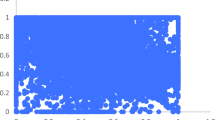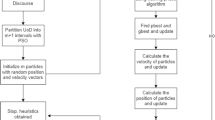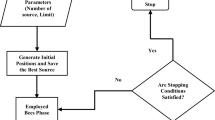Abstract
Recently, many forecasting methods have been proposed for the analysis of fuzzy time series. The main factors that affect the results of the forecasting of these models are partition universe of discourse and determination of fuzzy relations. In this paper, a novel fuzzy time series forecasting method which uses a hybrid artificial fish swarm optimization algorithm for the determination of interval lengths is proposed. Firstly, we introduce the chemotactic behavior of Bacterial foraging optimization into foraging behavior. Secondly, the Levy flight is used as the mutation operator for a mutation strategy. Finally, the new proposed method is applied to a fuzzy time series forecasting and the experimental results show that the proposed model obtain better forecasting results than those of other existing models. It proves the feasibility and validity of above-mentioned approaches.




Similar content being viewed by others
Explore related subjects
Discover the latest articles, news and stories from top researchers in related subjects.References
Aladag CH, Yolcu U, Egrioglu E (2012) A new time invariant fuzzy time series forecasting method based on particle swarm optimization. Appl Soft Comput 12(10):3291–3299
Aladag CH, Yolcu U, Uslu VR (2011) Fuzzy time series forecasting method based on Gustafson Kessel fuzzy clustering. Expert Syst Appl 38(8):10355–10357
Askari S, Montazerin N, Zarandi MHF (2015) A clustering based forecasting algorithm for multivariable fuzzy time series using linear combinations of independent variables. Appl Soft Comput 35(10):151–160
Bas E, Uslu VR, Yolcu U (2014) A modified genetic algorithm for forecasting fuzzy time series. Appl Intell 41(2):453–463
Chechkin AV, Metzler R, Klafter J, Gonchar VY (2008) Introduction to the theory of Levy flights, Anomalous Transport: Foundations and Applications. Wiley, Hoboken
Chen SM, Chung NY (2006) Forecasting enrollments using high-order fuzzy time series and genetic algorithms. Int J Intell Syst 21(5):485–501
Chen SM (2002) Forecasting enrollments based on high-order fuzzy time series. Cybern Syst 33(1):1–16
Cheng CH, Cheng GW, Wang JW (2008) Multi-attribute fuzzy time series method based on fuzzy clustering. Expert Syst Appl 34(2):1235–1242
Egrioglu E, Aladag CH, Yolcu U (2010) Finding an optimal interval length in high order fuzzy time series. Expert Syst Appl 37(7):5052–5055
Egrioglu E (2012) A new time-invariant fuzzy time series forecasting method based on genetic algorithm. Adv Fuzzy Syst 2012(3):1437–1450
Edwards AM, Phillips RA (2007) Revisiting Lvy flight search patterns of wandering albatrosses, bumblebees and deer. Nature 449(7165):1044–1048
Huarng K (2001) Effective lengths of intervals to improve forecasting in fuzzy time series. Fuzzy Sets Syst 123(3):387–394
Hsu LY, Horng SJ, et al (2010) Temperature prediction and TAIFEX forecasting based on fuzzy relationships and MTPSO techniques. Expert Syst Appl 37(4):2756–2770
Huang YL, Horng SJ, He M (2011) A hybrid forecasting model for enrollments based on aggregated fuzzy time series and particle swarm optimization. Expert Syst Appl 38(7):8014–8023
Hakli H, Uguz H (2014) A novel particle swarm optimization algorithm with Levy flight. Appl Soft Comput 23(5):333–345
Hwang JR, Chen SM, Lee CH (1998) Handling forecasting problems using fuzzy time series. Fuzzy Sets Syst 100(1–3):217–228
Jensi R, Jiji GW (2016) An enhanced particle swarm optimization with Levy flight for global optimization. Appl Soft Comput 43:248–261
Kuo IH, Horng SJ, Kao TW (2009) An improved method for forecasting enrollments based on fuzzy time series and particle swarm optimization. Expert Syst Appl 36(3):6108–6117
Kuo IH, Horng ST, Chen YH (2010) Forecasting TAIFEX based on fuzzy time series and particle swarm optimization. Expert Syst Appl 37(2):1494–1502
Lee LW, Wang LH, Chen SM (2008) Temperature prediction and TAIFEX forecasting based on high order fuzzy logical relationships and genetic simulated annealing techniques. Expert Syst Appl 34(1):328–336
Li XL, Shao ZJ (2002) An optimizing method based on autonomous animats: fish-swarm algorithm. Syst Eng Theory Pract 22(11):32–38
Passino KM (2002) Biomimicry of bacterial foraging for distributed optimization and control. IEEE Control Syst 22(3):52–67
Song Q, Chissom BS (1993) Fuzzy time series and its models. Fuzzy Sets Syst 54(1):269–277
Song Q, Chissom BS (1993) Forecasting enrollments with fuzzy time series: part I. Fuzzy Sets Syst 54(1):1–10
Song Q, Chissom BS (1994) Forecasting enrollments with fuzzy time series: part II. Fuzzy Sets Syst 62(1):1–8
Singh SR (2007) A simple method of forecasting based on fuzzy time series. Appl Math Comput 186(1):330–339
Viswanathan GM, Afanasyev V, Buldyrev SV (1996) Levy flight search patterns of wandering albatrosses. Nature 381(6581):413–415
Wong WK, Bai E, Chu AW (2010) Adaptive time-variant models for fuzzy time series forecasting. IEEE Trans Syst Man Cybern (Part B) 40(6):1531–1542
Wei L, Chen X, Pedrycz W (2015) Using interval information granules to improve forecasting in fuzzy time series. Int J Approx Reason 57:1–18
Yolcu U, Aladag CH (2013) Time series forecasting with a novel fuzzy time series approach: an example for Istanbul stock market. J Stat Comput Simul 83(4):599–612
Yang XS, Deb S (2013) Multiobjective cuckoo search for design optimization. Comput Oper Res 40(6):1616–1624
Zadeh LA (1965) Fuzzy sets. Inf Control 8(3):338–353
Acknowledgements
The authors express their gratitude to the editor and the anonymous reviewers for their insightful and constructive comments. This work was supported by the Graduate Teaching Reform Research Program of Chongqing Municipal Education Commission (No. YJG143010), Chongqing research and innovation Project of Graduate students (No. CYS16172), and the National Natural Science Foundation of China (Nos. 61472056, 11671001).
Author information
Authors and Affiliations
Corresponding author
Ethics declarations
Conflict of interest
The authors declare that they have no conflict of interest.
Additional information
Communicated by V. Loia.
Rights and permissions
About this article
Cite this article
Xian, S., Zhang, J., Xiao, Y. et al. A novel fuzzy time series forecasting method based on the improved artificial fish swarm optimization algorithm. Soft Comput 22, 3907–3917 (2018). https://doi.org/10.1007/s00500-017-2601-z
Published:
Issue Date:
DOI: https://doi.org/10.1007/s00500-017-2601-z




